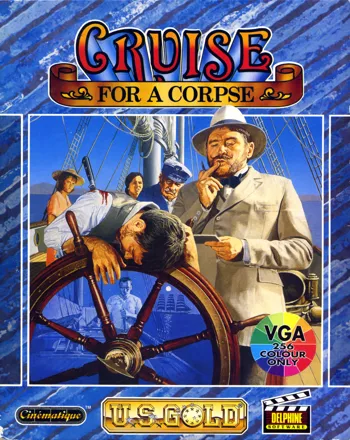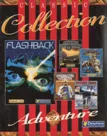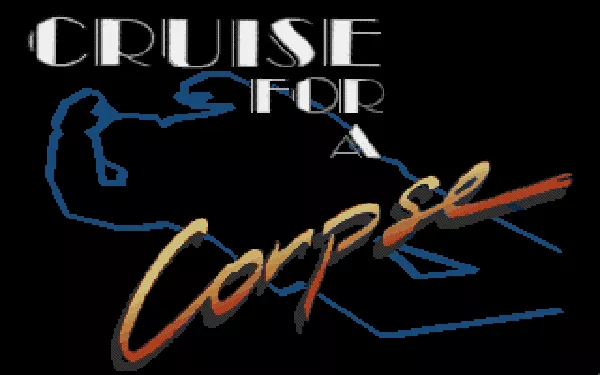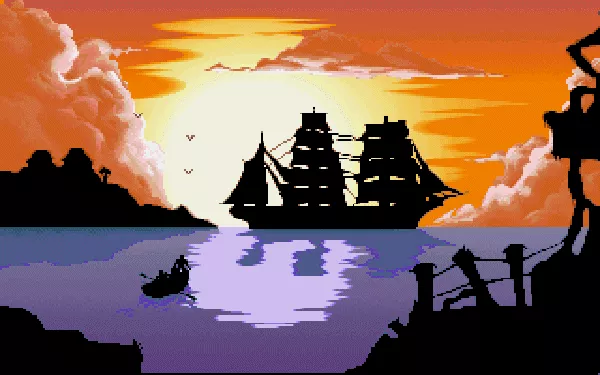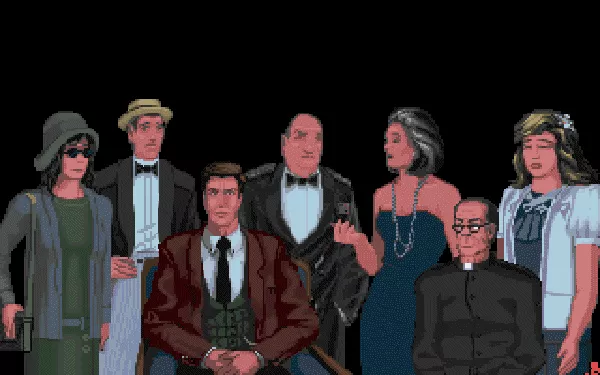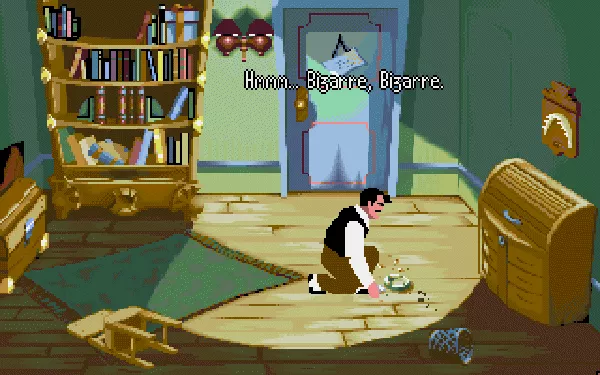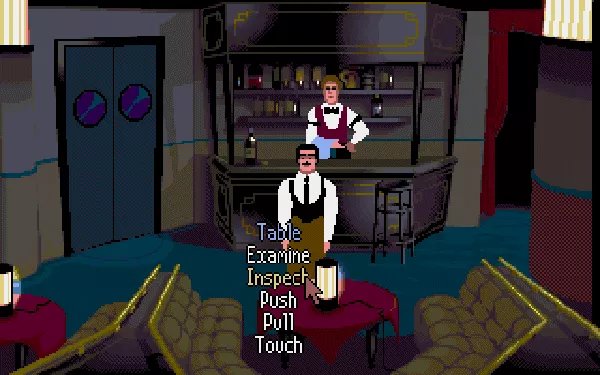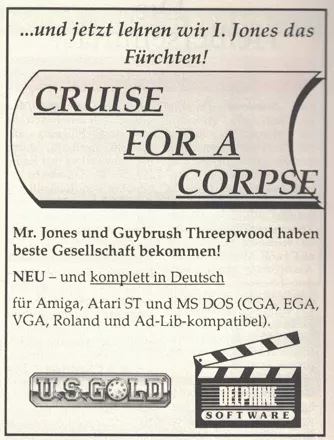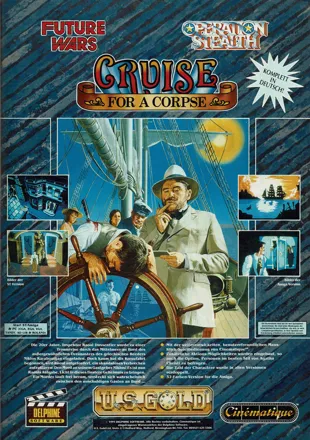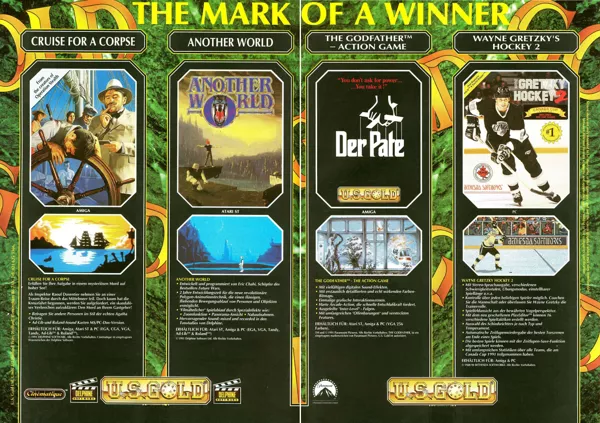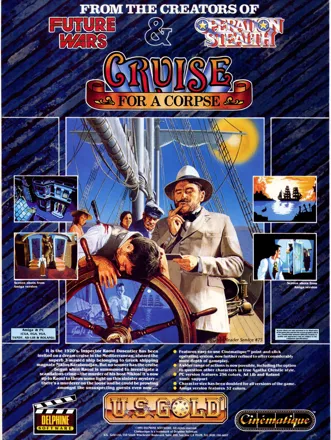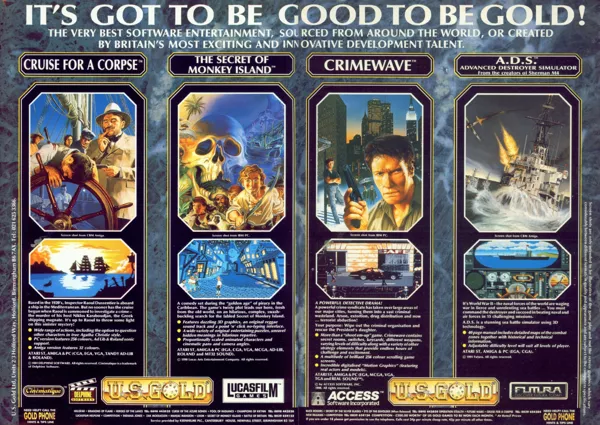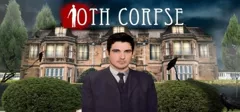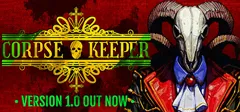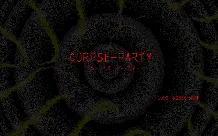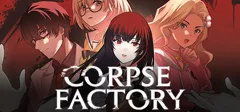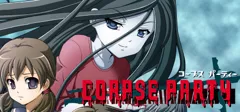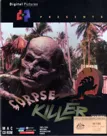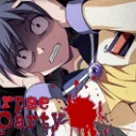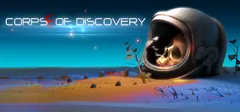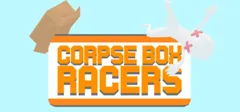Cruise for a Corpse
Description official descriptions
- When Inspector Raoul Dusentier is invited to a cruise upon a mighty sailing ship by the wealthy businessman Niklos Karaboudjan, he looks forward to nothing but a relaxing week on the sea. Instead, his host manages to get himself killed on the second day. Murdered, to be exact. Too convenient that a policeman is aboard -- Dusentier sets out to search for suspects. He doesn't need to search long. Why is it that none of the family members seem awfully sad about the demise of the old man? Is the mysterious Father Fabiani really as pious as he says? In the tradition of Agatha Christie, each and every person on board has a motive for the murder.
Cruise for a Corpse is a graphic adventure game with a point-and-click interface. You advance in the plot not so much by solving common object-based puzzles, but by talking to the right persons about the right subjects at the right time, thus collecting clues. You will also find pieces of evidence scattered throughout the ship. However, most items suddenly appear in cupboards and drawers that were previously empty. The clock advances in ten-minute-steps whenever you discover an interesting clue, which conveniently informs you of your progress. The protagonists move around the ship; so whenever time passes, different persons to talk to might appear at certain locations.
With this game, Delphine Software's Cinematique interface reached "Evolution 2". Instead of containing a fixed number of verbs, the command menu is now context-sensitive. The mouse cursor will change its appearance when moved over an interesting object; a left-click brings up a set of appropriate verbs. For example, a cupboard may be opened and searched, whereas a key can be picked up and turned. A right-click accesses the inventory. The game features polygonal characters.
Groups +
Screenshots
Promos
Credits (DOS version)
17 People (13 developers, 4 thanks) · View all
| Story Conception | |
| Cinematique Programming | |
| Cinematique System Evolution 2 | |
| Graphics | |
| Animation | |
| Music | |
| Sound Effects | |
| Quality Control | |
| Manual Illustrations | |
| Text Illustrations | |
| Packaging Concept | |
| Special Thanks To | |
| [ full credits ] | |
Reviews
Critics
Average score: 81% (based on 27 ratings)
Players
Average score: 3.8 out of 5 (based on 51 ratings with 4 reviews)
Taxing, frustrating and repetitive but in a sort of good way
The Good
I have been wanting to play this game for a long time and I received a copy in a bundle of DOS abandonware games for Christmas 2019, I played in 2020 using the SCUMM emulator.
Things I liked about this game
The in-game clock which shows progress through the game is a useful feature too. There were times when I did not reaslise that I'd uncovered a significant piece of information and this was a useful reminder to pay attention.
The save/load facility, which I started to use a lot late in the game, does not seem to have a limit to the number of slots which is always useful plus each save is accompanied by a thumbnail image which I find is a useful reminder when I restart the game after a break.
The Bad
Warning! This bit contains what some may consider minor spoilers. All of the points that caused me problems are covered by the general advice of trying every conversation option with every character repeatedly and searching every location thoroughly and repeatedly.
This is a well made game that I enjoyed but there are a couple of points where I felt the game didn't play fair.
In every instance where I tried to peer into a cabin Raoul failed to see anything, either there are reflections, it is too dirty, or he just doesn't like snooping. Eventually, as a player, I stopped looking only to find there is one instance where he will look through a porthole and observe something which is crucial to advancing the plot. That one instance where the my character does something that's out of character really jarred.
What happened was that the first character I clicked on was arrested even though I knew they were innocent and I just wanted to hear their story. Another short replay later and the bad guy/gal was taken away for a happy-ish ending
The Bottom Line
This game is set on a boat, that means a limited number of locations and a limited number of characters. The designers have sort of turned this into a feature by making it a requirement that, whenever something new is revealed, the player must revisit every location and search it again meticulously as well as questioning every character about everything once more. This is taxing, challenging, frustrating and it's meant to be which means it is not going to be everyone's cup of tea.
I was expecting a Lucas Arts style game and this is very different, I cannot recall a single sliding block puzzle, maze puzzle or a fiendish lock puzzle nor can I recall combining items in the inventory.
It's hard. I struggled with this game, I got stuck and had to resort to using a walkthrough several times. I never like doing that but in all honesty I don't think I could have completed it without a guide of some sort. I started the game on a Wednesday and completed it on the Saturday taking I guess around twenty-five hours of pleasurably frustrating gaming.
DOS · by piltdown_man (255478) · 2020
Wonderfully constructed adventure game with immaculate presentation
The Good
This game is great if you've ever wanted to be Hercule Poirot or Sherlock Holmes, it has all the elements of a classic "who-dunnit?". The game features beautiful graphics and wonderful music (especially for its time). Great characters, great plot and a great atmosphere. The ending won't let you down either!
The Bad
The English seemed a bit dodgy at times, and can get a bit frustrating when you get stuck.
The Bottom Line
The most amazing thing about this game is that it takes 6-8 hours to complete WITH a walkthrough helping you! If you want a laid back game to tax you mentally then this is it. Just try not to get too frustrated when you get stuck!
Amiga · by Johnny "ThunderPeel2001" Walker (476) · 2003
The Good
Being my first "cinematique" adventure game, I wasn't too sure what to expect from Cruise for a Corpse, having only heard some good things about it's original Amiga release.
The truth is that Delphine proved once again to be on top of things and released a stellar adventure jewel that should be better remembered by adventure fans.
Taking it's inspiration from the classic Agatha Christie/Arthur Conan Doyle detective novels, Delphine casts you as a classic early-twenty century detective a-la Hercule Poirot or Sherlock Holmes. As the game starts, a wealthy acquaintance invites you to spend some time on his luxury cruise along with a group of close friends and relatives of him. You don't get to enjoy much of the sea breeze however, as not long after you arrive your benefactor gets murdered. The ensuing scenario thus will be instantly familiar to anyone who's played "Clue": you find yourself isolated with no law enforcement in sight, everyone is a suspect and turns out to have lots of skeletons in their closets and reasons to have the victim murdered, and returning home will only allow the murderer to flee, thus your pleasure cruise has just turned into a race to find the murderer using nothing but your wits and deductive instinct.
The game starts on the right track by taking the detective-oriented gameplay and not messing it with the usual crappy "adventuresque" inventory-related annoyances. Basically, the game revolves around you triggering flags, be it by talking about a specific topic with someone or by uncovering a clue. Whenever something like that happens, the game's clock advances a few minutes and you go at it again, as somewhere in the boat a new clue awaits to be uncovered or an event waits for you to pass by and trigger it. This works wonders to create the feeling of a tangible plot that develops following your lead. And while it may translate into a completely linear affair, the game makes the stellar decision of following this gameflow only until the final moment, were true to it's mystery novel roots, the entire cast of characters gets comes to meet you and the final decision of who's guilty falls entirely on your hands, as it's up to you to weight all the clues and threads you collected in the game and decide who did it. Obviously, there's only one right answer and the other ones lead you to a generic ending, but it's still a great touch.
The most impressive aspect of the game however, is the technical one. True to Delphine tradition, the game uses filled-vectors graphics for characters, which translate into silky smooth character animations and which meld perfectly with the backgrounds. The game's interface is an example of class, with a fully mouse-driven context-sensitive floating menu that appears whenever you right-click and which gives you easy access to the classic verb menu and the inventory. Further refinement comes with the use of an overhead map of the vessel, from which you can easily navigate your character and "warp" to each part of the ship without having to walk all over the decks. And the dialogue tree-interface is equally well crafted, with a collection of topics and sub-topics for each character that allow you to easily sort all the massive amounts of information each character has to share with you.
The Bad
The vector graphics aren't fit for all situations, and you'll easily see why whenever your character comes close to the camera and his model explodes into blocky chunks that remind the player more of lego blocks than anything else.
Also, the distinctive gameflow has the problem of causing lots of stucky situations. A lot of times you'll be wondering aimlessly just because you haven't stumbled with the next clue or event. I would also have appreciated a graphic inventory instead of the text list.
The Bottom Line
A fantastic detectivesque adventure game, wonderfully designed and a true rare jewel of the adventure genre. Now I'm really interested about Delphine's Cinematique games.
DOS · by Zovni (10502) · 2005
Trivia
1001 Video Games
Cruise for a Corpse appears in the book 1001 Video Games You Must Play Before You Die by General Editor Tony Mott.ž
Polygon
Cruise for a Corpse is notable for a technical feature: Most animated objects in the game, from door to persons, are filled vectors rather than bitmaps. This allows for animations which are not only fluent, but consume only a fraction of the disk space that sprites would require. Also, the figures are scalable without loss of detail, although the rather crude vector models used in Cruise for a Corpse are not too spectacular in close-ups.
The Delphine team demonstrated its mastery of the polygon technology impressively -- unfortunately not so much in the game itself than in the ending sequence. It consists of roughly a dozend second-long full-screen animations consisting entirely of vectors. This was an astounding display at the time.
By 1992, Delphine had already successfully used the vector technology in two games (Cruise for a Corpse and Another World). However, it was another game that made it truly popular in that year: Alone in the Dark. Incidentally, this highly successful action-adventure was developed by Infogrames, another French company.
References
There are a couple of references to Operation: Stealth, one of Delphine's earlier games: at one point you discover the name 'Ostrovitch' (Ostrovitch and Karpov were two Soviet agents from that game). Also, if you examine a waste basket in the toilet, the game will tell you that there is 'no razor' this time (referring to a certain puzzle in that game).
At the epilogue of the game, one character is described 'rich as Donald Trump'. However since the game is set in 1927, it is an historical error: Trump would not be born until 20 years later!
The game includes a few elements which can be understood as references to classical French language comics. For example, the victim's name 'Karaboudjan' is the name of a ship in the Tintin comic-strip album The Crab with the Golden Claws by Hergé. At a point of the game, you discover a tin can of crab meat, as a cover for a smuggling operation, exactly as in the comic book. Finally, a puzzle includes the name "Incal", which is possibly a reference to the title of the comic book by the same name by Alejandro Jodorowsky and Moebius.
Awards
- ST Format
- January 1993 (issue #42) - #35 in '50 finest Atari ST games of all time' list
Analytics
Upgrade to MobyPro to view research rankings and price history! (when applicable)
Related Sites +
-
ScummVM
supports Cruise for a Corpse under Windows, Linux, Macintosh and other platforms.
Identifiers +
Contribute
Are you familiar with this game? Help document and preserve this entry in video game history! If your contribution is approved, you will earn points and be credited as a contributor.
Contributors to this Entry
Game added by -Chris.
Amiga added by POMAH. Atari ST added by Kabushi.
Additional contributors: Boston Low, Macs Black, Plok, Jo ST, FatherJack.
Game added August 29, 2000. Last modified November 10, 2024.


